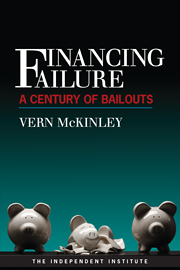At the height of the presidential election campaign, the Treasury Department issued a press release called “Further Steps to Expedite Wind Down of Fannie Mae and Freddie Mac.” It highlighted a new policy to scale back the pair’s mortgage-investment portfolio at a rate of 15% per year, as opposed to their stated 10% rate. Reports from the Securities and Exchange Commission, however, suggest that these two government-sponsored enterprises—currently under federal conservatorship—may not be shrinking much at all.
The Treasury announcement, coming near the fourth anniversary of the September 2008 government takeover of the mortgage behemoths, was made during an election campaign with a heavy focus on the health of the economy. The impression it left was that the most expensive of the 2008 bailouts was not much of an issue, as the transition back to stability in the mortgage market is well under way.
We’ve since learned that the mortgage market is still troubled—given the report on Friday that the Federal Housing Administration, a government agency, faces high losses on its mortgage loans and may need to get billions from the U.S. Treasury to shore up its finances.
Forbes magazine referred to the August Treasury announcement as “Obama’s Victory Lap.” Fannie and Freddie’s caretaker and regulator, the Federal Housing Finance Agency, chimed in that the “faster reduction in the retained mortgage portfolio will further reduce risk exposure and simplify the operations of Fannie Mae and Freddie Mac.”
But these comments raise questions when you cross-check the claims against the annual and quarterly reports, Forms 10-K and 10-Q, that Fannie Mae filed with the SEC.
Fannie Mae, by far the larger of the two institutions, has a mortgage balance that has hovered at $2.9 trillion since early 2010, the reports show. Freddie Mac has managed to shrink its mortgages, but only slightly.
Exactly what 10% wind-down rate was the Treasury Department referring to in its press release? Once again, the SEC reports for Fannie are helpful as they explain the basis for some of the comments: “The senior preferred stock purchase agreement with Treasury includes a number of covenants that significantly restrict our business activities . . . the maximum allowable amount of mortgage assets [Fannie Mae was] permitted to own on December 31, 2011 was $729 billion.”
In other words, when Treasury bailed out Fannie and Freddie, part of that deal was a cap on the mortgage assets they could “own.” This cap has gone down 10% per year and will now go down 15%. At least in theory, this mandate could lead to sustained shrinkage in the assets and overall presence of Fannie and Freddie.
But the stated cap for “owned” assets, $729 billion in Fannie’s case, represents only a small portion of the $2.9 trillion in mortgages on Fannie’s balance sheet.
Fannie and Freddie have a great deal of risk exposure from “guaranteeing” mortgages. Measured as a proportion of Fannie’s total mortgage assets, owned assets represent only a little more than 25%, while the bulk of its total mortgage loans fall into the category of loans it guarantees.
Treasury also failed to mention staff levels in its announcement.
Surely Fannie and Freddie are starting to rationalize and reduce their far-flung operations as fully private institutions after four years in government hands. They were placed in a legal conservatorship, after all; so what better way to conserve resources than to reduce excesses in payroll—especially when one considers Fannie’s $16.9 billion net loss last year?
“Fannie Mae Laying Off Hundreds,” read a Washington Post headline from early 2009, a few months after the government takeover. The headline focused on the Washington, D.C., office. Elsewhere, the article noted that Fannie’s Dallas office was hiring, and overall staffing levels were expected to remain flat. Once again, cross-checking the SEC reports undermines any doomsday narrative about staff shrinkage.
Fannie Mae had 5,800 employees in late 2008, shortly after the government takeover. As of early 2012 it had bulked up to 7,000 employees. This was down from a peak of 7,300 employees in 2011, but still up 1,200 since the start of government conservatorship. Again, Freddie Mac has managed to reduce staff slightly, but the amount—about 90 total—pales in comparison to the 1,200-employee bump at Fannie.
These facts expose the Treasury announcement as misleading at best, and confirm that the wind-down mission has not been accomplished.
Certainly, the efforts to date don’t deserve a victory lap, although Freddie Mac has made modest progress, which is more than can be said for Fannie Mae. If Treasury wants to trumpet shrinkage, Fannie and Freddie need to downsize their entire mortgage portfolio, owned and guaranteed, and scale back their army of employees.
Then, perhaps, a victory lap might be appropriate.







